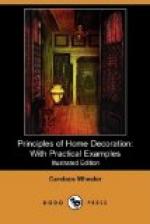The range of possible treatment is very wide, from simple tones of wall colour against which quiet cottage or domestic city life goes on, to the elaboration of walls of houses of a different grade, where stately pageants are a part of the drama of daily life. But having shown that certain rules are applicable to both, and indeed necessary to success in both, we may choose within these rules any tint or colour which is personally pleasing.
Rooms with an east or west light may carry successfully tones of any shade, without violating fundamental laws.
The first impression of a room depends upon the walls. In fact, rooms are good or bad, agreeable or ugly in exact accordance with the wall-quality and treatment. No richness of floor-covering, draperies, or furniture can minimise their influence.
Perhaps it is for this reason that the world is full of papers and other devices for making walls agreeable; and we cannot wonder at this, when we reflect that something of the kind is necessary to the aspect of the room, and that each room effects for the individual exactly what the outer walls of the house effect for the family, they give space for personal privacy and for that reserve of the individual which is the earliest effect of luxury and comfort.
It is certain that if walls are not made agreeable there is in them something of restraint to the eye and the sense which is altogether disagreeable. Apparent confinement within given limits, is, on the whole, repugnant to either the natural or civilised man, and for this reason we are constantly tempted to disguise the limit and to cover the wall in such a way as shall interest and make us forget our bounds. In this case, the idea of decoration is, to make the walls a barrier of colour only, instead of hard, unyielding masonry; to take away the sense of being shut in a box, and give instead freedom to thought and pleasure to the sense.
It is the effect of shut-in-ness which the square and rigid walls of a room give that makes drapery so effective and welcome, and which also gives value to the practice of covering walls with silks or other textiles. The softened surface takes away the sense of restraint. We hang our walls with pictures, or cover them with textiles, or with paper which carries design, or even colour them with pigments—something—anything, which will disguise a restraining bound, or make it masquerade as a luxury.
This effort or instinct has set in motion the machinery of the world. It has created tapestries and brocades for castle and palace, and invented cheap substitutes for these costly products, so that the smallest and poorest house as well as the richest can cover its walls with something pleasant to the eye and suggestive to the mind.
[Illustration: LARGE SITTING-ROOM IN “STAR ROCK” COUNTRY HOUSE]
It is one of the privileges and opportunities of art to invent these disguises; and to do it so thoroughly and successfully as to content us with facts which would otherwise be disagreeable. And we do, by these various devices, make our walls so hospitable to our thoughts that we take positive and continual pleasure in them.




